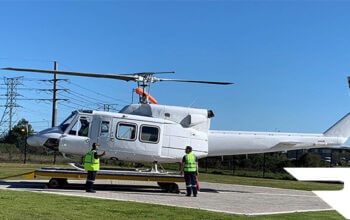As part of an initiative to reduce and remove Volatile Organic Compounds (VOCs) from fuel tank manufacturing processes, engineers and scientists at GKN Aerospace in Portsmouth, UK, have developed the first single-skin flexible fuel bladder material that is able to offer crash resistance and puncture tolerance. The Company will launch this new development at Heli-Expo in Houston, Tx, this month with a display of the material on the Company’s stand.
Frank Bamford, Senior Vice President of Business Development and Strategy comments: “We estimate that use of this material could lead to a 60% reduction in the use of VOC’s and a 30% reduction in manufacturing times – whilst the weight of each fuel bladder could be reduced by approximately 5% through the removal of the adhesive coatings used in traditional bladder construction.”
To provide effective crash resistance of the necessary standard, fuel bladders for the aerospace sector have traditionally been manufactured using multiple layers of composite materials with adhesives joining the bladder to the protective textile layers. This has involved a manufacturing process using solvent-based adhesives and the application of a final lacquer coating to protect the exterior of the fuel bladder.

This innovative new material is manufactured from a thermoplastic polymer rather than traditional nitrile rubber and incorporates the crash resistant textile within it. The material also contains an integrated fuel barrier to provide the same level of fuel tolerance exhibited by traditional tanks. This means the crash resistant layer is not applied using adhesives and no final lacquer coating is required, significantly reducing VOC solvent use.
Additional environmental benefits from the new tank assembly process include the removal of ozone depleting chemicals that are used in traditional rubber manufacture and the elimination of most fuel tank manufacturing adhesives and the solvents they contain, because the polyurethane basis of the new material will allow the use of radio frequency welding of the tank structure.
Bamford concludes: “As a Company our R&D effort in all our businesses is targeted on developing and applying new technologies to bring real and practical benefits to aerospace. Without doubt, this new material represents a huge progression in the flexible transportation of fuel for helicopter operators and others. It will bring a technological step-change into this sector with appreciable environmental and operational benefits. And this is our second new product launch at Heli Expo where our team is also discussing, for the first time, our new emergency flotation system technology.”








